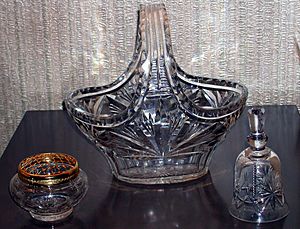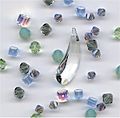Lead glass facts for kids
Lead glass, also known as lead crystal, is a special type of glass that contains lead. Unlike regular glass, which uses calcium oxide, lead glass replaces this with lead(II) oxide. This change makes lead glass look and feel different. It is often used for decorative items because of its unique sparkle and shine.
Contents
What is Lead Glass?
Lead glass is a kind of glass that has lead added to its ingredients. The lead is usually in the form of lead(II) oxide. This is different from common glass, which uses calcium oxide instead. The lead makes the glass heavier and changes how light passes through it.
How is it Different?
Lead glass has several interesting properties that make it stand out from regular glass. These properties include its appearance, how it sounds, and even how it interacts with certain types of energy.
Why Does it Look Different?
The lead atoms in lead glass are very large and heavy. This changes how light bends when it goes through the glass. This bending of light is called refraction. Because of this, lead glass often has a beautiful sparkle, similar to a diamond. This is why it is popular for fancy drinking glasses, vases, and chandeliers.
Other Cool Properties
Lead glass also has other unique features:
- Sound: If you gently tap lead glass, it often makes a clear, ringing sound. Regular glass usually makes a duller sound when tapped.
- X-ray Protection: Lead glass can block some X-rays. Because of this, it is sometimes used in places like hospitals. It helps protect people from harmful X-rays during medical procedures.
- Insulation: It is also a good insulator. This means it does not easily let heat or electricity pass through it.
Is Lead Glass Safe to Use?
While lead glass is beautiful and has useful properties, it is important to know about its safety. Because it contains lead, there are some things to consider, especially when it comes to food and drinks.
What About Food and Drinks?
Small amounts of lead can sometimes move from the glass into food or drinks. This is more likely to happen if food or drinks are stored in lead glass for a long time. Foods that are acidic, like orange juice, vinegar, or wine, can make this happen more easily. For this reason, it is generally safer to use lead glass for decorative purposes rather than for everyday food and drink storage.
Images for kids
See also
 In Spanish: Vidrio de plomo para niños
In Spanish: Vidrio de plomo para niños





